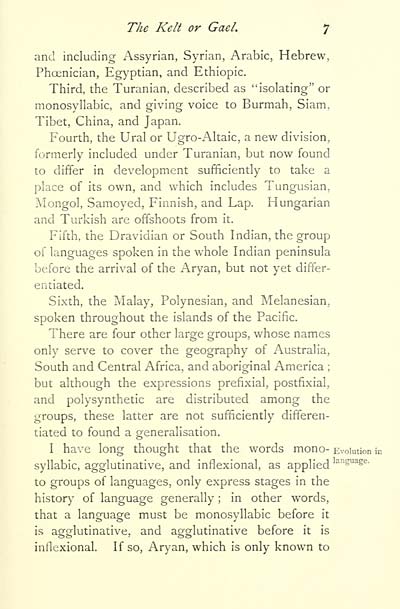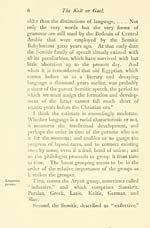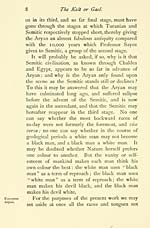Blair Collection > Kelt or Gael
(11)
Download files
Complete book:
Individual page:
Thumbnail gallery: Grid view | List view

The Kelt or Gael. 7
and including Assyrian, Syrian, Arabic, Hebrew,
Phoenician, Egyptian, and Ethiopic.
Third, the Turanian, described as "isolating" or
monosyllabic, and giving voice to Burmah, Siam,
Tibet, China, and Japan.
Fourth, the Ural or Ugro-Altaic, a new division,
formerly included under Turanian, but now found
to differ in development sufficiently to take a
place of its own, and which includes Tungusian,
Mongol, Samoyed, Finnish, and Lap. Hungarian
and Turkish are offshoots from it.
Fifth, the Dravidian or South Indian, the group
of languages spoken in the whole Indian peninsula
before the arrival of the Aryan, but not yet differ-
entiated.
Sixth, the Malay, Polynesian, and Melanesian,
spoken throughout the islands of the Pacific.
There are four other large groups, whose names
only serve to cover the geography of Australia,
South and Central Africa, and aboriginal America ;
but although the expressions prefixial, postfixial,
and polysynthetic are distributed among the
groups, these latter are not sufficiently differen-
tiated to found a generalisation.
I have long thought that the words mono- Evolution ir
syllabic, agglutinative, and inflexional, as applied ^^"^"^g^-
to groups of languages, only express stages in the
histor}- of language generally ; in other words,
that a language must be monosyllabic before it
is agglutinative, and agglutinative before it is
inflexional. If so, Aryan, which is only known to
and including Assyrian, Syrian, Arabic, Hebrew,
Phoenician, Egyptian, and Ethiopic.
Third, the Turanian, described as "isolating" or
monosyllabic, and giving voice to Burmah, Siam,
Tibet, China, and Japan.
Fourth, the Ural or Ugro-Altaic, a new division,
formerly included under Turanian, but now found
to differ in development sufficiently to take a
place of its own, and which includes Tungusian,
Mongol, Samoyed, Finnish, and Lap. Hungarian
and Turkish are offshoots from it.
Fifth, the Dravidian or South Indian, the group
of languages spoken in the whole Indian peninsula
before the arrival of the Aryan, but not yet differ-
entiated.
Sixth, the Malay, Polynesian, and Melanesian,
spoken throughout the islands of the Pacific.
There are four other large groups, whose names
only serve to cover the geography of Australia,
South and Central Africa, and aboriginal America ;
but although the expressions prefixial, postfixial,
and polysynthetic are distributed among the
groups, these latter are not sufficiently differen-
tiated to found a generalisation.
I have long thought that the words mono- Evolution ir
syllabic, agglutinative, and inflexional, as applied ^^"^"^g^-
to groups of languages, only express stages in the
histor}- of language generally ; in other words,
that a language must be monosyllabic before it
is agglutinative, and agglutinative before it is
inflexional. If so, Aryan, which is only known to
Set display mode to: Large image | Transcription
Images and transcriptions on this page, including medium image downloads, may be used under the Creative Commons Attribution 4.0 International Licence unless otherwise stated. ![]()
| Early Gaelic Book Collections > Blair Collection > Kelt or Gael > (11) |
|---|
| Permanent URL | https://digital.nls.uk/75786802 |
|---|
| Description | His ethnography, geography and philology. |
|---|---|
| Shelfmark | Blair.17 |
| Additional NLS resources: | |
| Attribution and copyright: |
|
| Description | A selection of books from a collection of more than 500 titles, mostly on religious and literary topics. Also includes some material dealing with other Celtic languages and societies. Collection created towards the end of the 19th century by Lady Evelyn Stewart Murray. |
|---|
| Description | Selected items from five 'Special and Named Printed Collections'. Includes books in Gaelic and other Celtic languages, works about the Gaels, their languages, literature, culture and history. |
|---|

